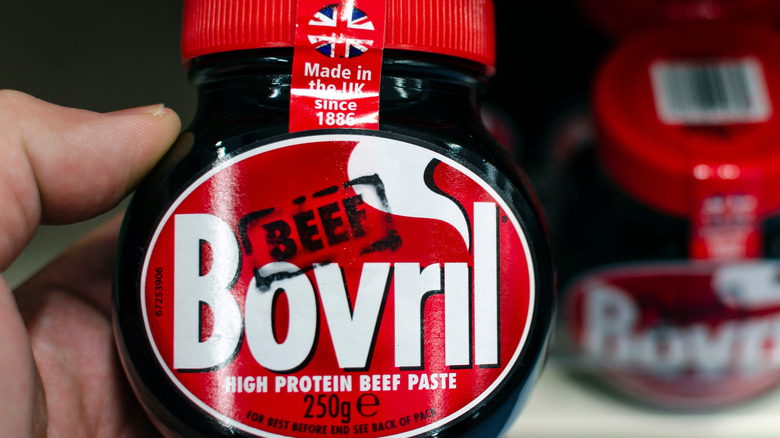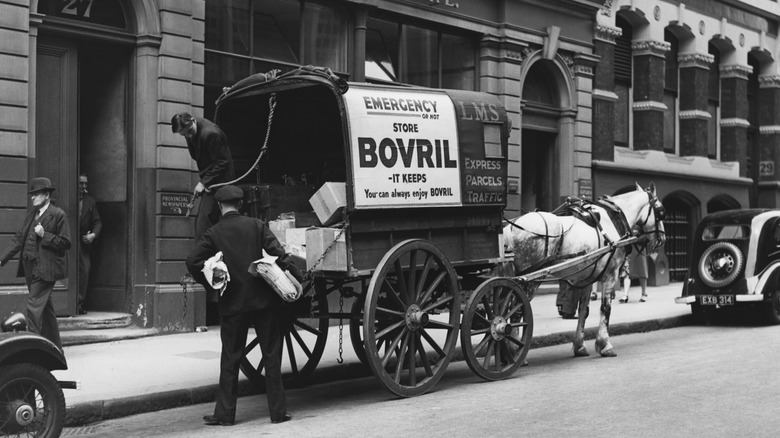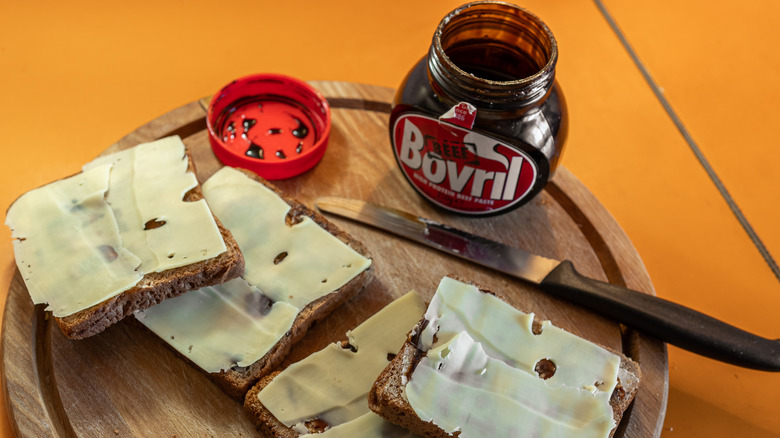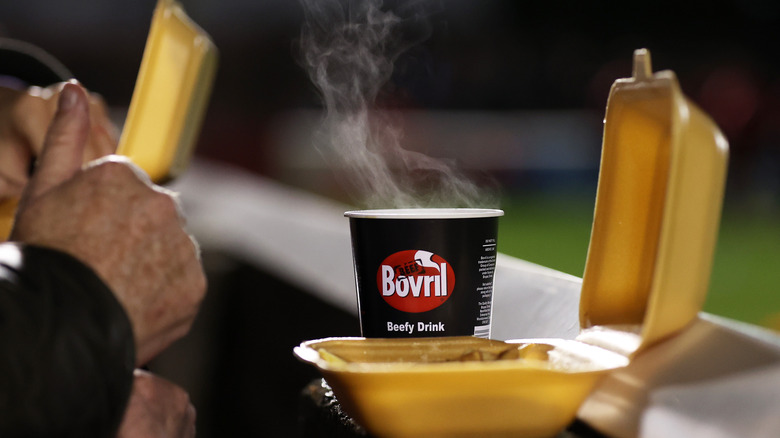The Rich History Of Bovril And How People Drink This Meaty Extract
Some foods are inherently polarizing, either inspiring a grimace or fierce fondness. Oftentimes, they feature a bold, savory flavor; think Vegemite or olives. If you're a fan of such qualities — as well as beef — it's time to add Bovril to your list of foods to try.
This rich, paste-textured spread is derived from beef and stored in a condiment jar. Its flavor is salty yet sweet, and beef-forward, underpinned by notes of bitter compounds like coffee, tobacco, and chocolate. Many enjoy Bovril as a spread by smearing a spoonful on toast, while others brew it into a tea for drinking. This paste can also be used as a component in a broth. No matter how you consume it, its meaty constitution is unlike anything else. Hailing from Victorian-era Britain, Bovril is a relic of a different period in food production. Though it was originally boasted as a health-boosting extract, it's no longer so strongly marketed, yet it continues to thrive. Let's dive into the details of how it came about.
History of Bovril
Bovril originated in the early 1870s in the hands of John Lawson Johnston, a Scottish butcher and nutritionist. His aim was to create a shelf-stable meat product that could fulfill dietary needs. After employing it as a military ration, Johnston adeptly organized a state-of-the-art manufacturing system across continents. He sourced cows in distant locales like South America and Australia, devising a way to package and sell beef with a profit. As a result, Bovril's production exploded in popularity throughout the late 1800s.
To aid its expansion, clever advertising placed Bovril alongside images of strength and stamina. Even the logo — a bull — showcased the powers of packaged foods during their first emergence. Such sensibilities were further amplified by medical-backed marketing, which vouched for its immune-boosting qualities. Bovril reached a peak in the 1930s, with sustained popularity into the 1960s. At that point, the product declined in prominence, although it's still in production. Today, it continues as a relic of British culture and is exported to several countries.
What's in Bovril?
Bovril's manufacturing method has altered over the decades — there was even a season when it was vegetarian. Today, it's sold with a yeast extract base similar to Vegemite, compounded with soy proteins, beef stock, and flavorings. However, Johnston's original process was fully beef-based, using albumin, the principal protein from plasma. The substance would then be mixed with lean, dehydrated beef and ground into a powder, which would later be turned into a paste.
Both production methods, including the modern method, create a nutritionally-dense substance. A single teaspoon of Bovril yields 4.5 grams of proteins and 1.6 grams of carbs, but it comes at a cost of 1,400 milligrams of sodium, which is over half of the daily recommendation, notes LiveStrong. Such a potent constitution does make Bovril more than just a cooking component, though. When dissolved into a glass of water, it makes for a quick, protein-rich drinkable boost.
How and why do people drink Bovril?
Bovril's consumption as a beverage stems from its origins when tonics were popular. As such, it was promoted as a healthy, nutritional alternative to alcohol. Plus, serving it as a drink expanded its accessibility, enabling it to be consumed in schools and hospitals, as well as by the military. Most famously, Bovril is consumed as a beef tea. A spoonful is dissolved in a cup of hot water, and the drink is sipped on as a meal accompaniment. Its savory, salty, and warming quality give it a nourishing character reminiscent of a rich bone broth. Some deviations even make it refreshing by combining it with milk or in a glass of carbonated water.
Today, Bovril is less popular than it was a century back. Yet, it still carries a nostalgia that perpetuates its consumption. Frequently sipped on at soccer games in an ode to British culture, it's warming to know the beefy concoction is still around.



